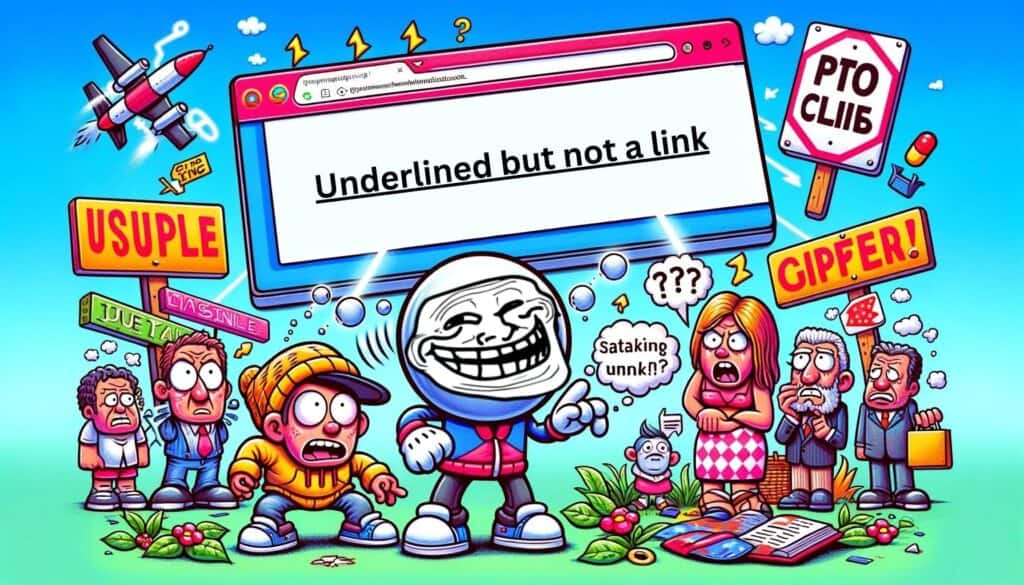
Understanding User Experience and Web Design
In Web design, every element on a webpage carries weight and meaning. Underlining text, a common practice in print to emphasize points, plays a different role in the digital world. Traditionally, underlined text on websites signifies hyperlinks. This established convention is a cornerstone of user experience (UX) design, guiding users seamlessly through a website. Breaking this rule by underlining plain text (non-hyperlinked text) can lead to confusion and a degraded user experience.
The Confusion of Misused Underlines
When users encounter underlined text on a website, they instinctively expect it to be clickable. This expectation is rooted in decades of web browsing experience where underlined text is synonymous with hyperlinks. Deviating from this norm by underlining plain text can lead to frustration as users click on what they believe are links, only to find that nothing happens. This confusion disrupts the browsing experience and can diminish the user’s trust in the website’s design and content.
Impact on Accessibility
Web accessibility is a crucial aspect of design, ensuring that all users, including those with disabilities, can access and navigate websites. Underlined text can be particularly challenging for individuals with visual impairments or cognitive disorders. For these users, distinguishing between underlined hyperlinks and plain text can be difficult, leading to a frustrating and inaccessible browsing experience.
Aesthetic Considerations
From an aesthetic standpoint, underlining plain text can clutter a webpage and detract from its visual appeal. Underlines can disrupt the flow of text, making it harder to read and visually unappealing. This can be especially problematic on websites where clean, minimalistic design is key to the user experience.
SEO Implications of Underlining Plain Text
Search Engine Optimization (SEO) is vital for any website’s visibility and traffic. While underlining plain text doesn’t directly affect SEO rankings, it can indirectly impact them through user engagement metrics.
User Engagement and Bounce Rates
If visitors are frustrated or confused by underlined plain text, they are more likely to leave the site quickly, increasing the bounce rate. High bounce rates can signal to search engines that the content is not engaging or relevant, potentially harming the website’s search rankings.
Impact on Content Quality Perception
Search engines increasingly use sophisticated algorithms to assess the quality of website content. A site that misuses underlining may be perceived as lower quality or less professional, which can indirectly affect its ranking.
Distracting from Actual Hyperlinks
Overusing underlines can dilute the impact of actual hyperlinks. When hyperlinks are less distinguishable, it can lead to reduced click-through rates (CTRs), impacting the site’s engagement metrics and SEO performance.
Alternatives to Underlining in Web Design
Acknowledging the drawbacks of underlining plain text, it’s essential to explore alternatives that enhance user experience and website aesthetics.
Emphasis Through Font Styles and Colors
Utilizing different font styles (like italics or bold) or changing the text color can be effective ways to emphasize text without misleading users. These methods maintain clarity and keep the design user-friendly.
Using Backgrounds and Borders
Applying background colors or borders to text can highlight important information without implying interactivity. This approach can be particularly effective in drawing attention to specific sections or quotes.
Incorporating Icons and Graphics
Icons and graphics can be used alongside text to draw attention and add visual interest. They can also help in breaking the monotony of long text passages, making the content more engaging and easier to navigate.
More Things to Consider
While we’ve covered the primary reasons why underlining plain text on a website is not advisable, there are additional factors to consider that can influence the decision.
Consistency with Web Standards
Following established web standards not only improves user experience but also ensures consistency across different platforms and devices. Deviating from these standards by underlining plain text can lead to inconsistent experiences, especially on mobile devices or when using different browsers.
Impact on International Audiences
Cultural differences in interpreting web design elements can also play a role. In some cultures, underlining might have different connotations, so it’s important to consider the target audience’s preferences and web browsing habits.
Testing and Feedback
Before finalizing any design element, including the use of underlines, it’s crucial to conduct user testing and gather feedback. Real-world user interactions can provide valuable insights into how design choices are perceived and interacted with.
While underlining plain text may seem like a minor design choice, its impact on user experience, accessibility, SEO, and overall website effectiveness is significant. By adhering to web design best practices and considering the alternatives mentioned, designers can create more user-friendly, engaging, and successful websites.






Leave a Reply